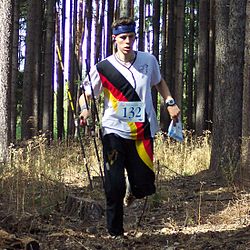Amateur radio direction finding

A German competitor on a 2-metre band ARDF course.
|
|
| Highest governing body | International Amateur Radio Union |
|---|---|
| First played | 1950s, in northern and eastern Europe |
| Characteristics | |
| Contact | Non-contact |
| Team members | Individual |
| Mixed gender | Separate categories |
| Type | Outdoor |
Amateur radio direction finding (ARDF, also known as radio orienteering and radiosport) is an amateur racing sport that combines radio direction finding with the map and compass skills of orienteering. It is a timed race in which individual competitors use a topographic map, a magnetic compass and radio direction finding apparatus to navigate through diverse wooded terrain while searching for radio transmitters. The rules of the sport and international competitions are organized by the International Amateur Radio Union. The sport has been most popular in Eastern Europe, Russia, and China, where it was often used in the physical education programs in schools.
ARDF events use radio frequencies on either the two-meter or eighty-meter amateur radio bands. These two bands were chosen because of their universal availability to amateur radio licensees in all countries. The radio equipment carried by competitors on a course must be capable of receiving the signal being transmitted by the five transmitters and useful for radio direction finding, including a radio receiver, attenuator, and directional antenna. Most equipment designs integrate all three components into one handheld device.
The sport originated in Northern Europe and Eastern Europe in the late 1950s. Amateur radio was widely promoted in the schools of Northern and Eastern Europe as a modern scientific and technical activity. Most medium to large cities hosted one or more amateur radio clubs at which members could congregate and learn about the technology and operation of radio equipment. One of the activities that schools and radio clubs promoted was radio direction finding, an activity that had important civil defense applications during the Cold War. As few individuals in Europe had personal automobiles at the time, most of this radio direction finding activity took place on foot, in parks, natural areas, or school campuses. The sport of orienteering, popular in its native Scandinavia, had begun to spread to more and more countries throughout Europe, including the nations of the Eastern Bloc. As orienteering became more popular and orienteering maps became more widely available, it was only natural to combine the two activities and hold radio direction finding events on orienteering maps.
...
Wikipedia
